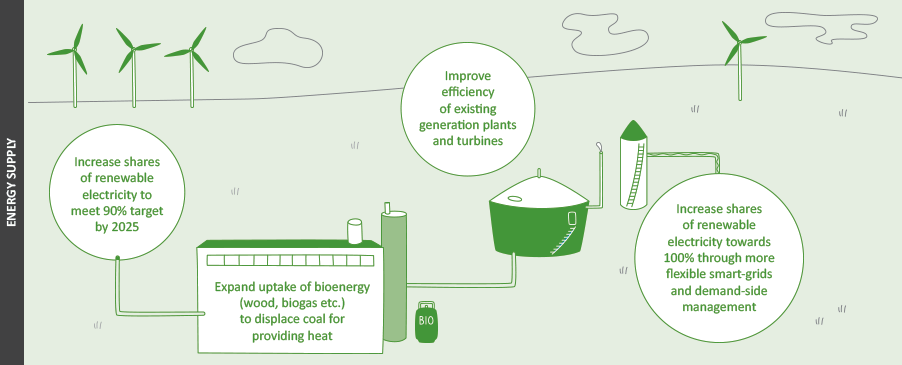Energy supply
This section covers mitigation options for energy supply, mainly heat and electricity supply not energy for transport. There are many opportunities to further reduce fossil fuel use in this sector. They include:
- Increase shares of renewable electricity to meet 90% target by 2025
- Expand update of bioenergy (wood, biogas etc) to displace coal for providing heat
- Improve efficiency of existing generation plants and turbines
- Increase shares of renewable electricity towards 100% through more flexible smart grids and demand-side management.
In pictures

Actions we can take in the energy supply sector now towards a low-carbon future for New Zealand

- Approximation of potential emission reductions in the heat supply sector

- Approximation of potential emission reductions in electricity supply sector
Key findings
- Around 80% of New Zealand’s electricity is generated from renewable sources (primarily hydropower).
- This can be further increased, cost effectively, to reach 90% by 2025 – New Zealand’s renewable electricity target.
- Technically renewables in the mix could achieve close to 100% without reducing the reliability and security of the power grid. However, very high penetration that includes high shares of variable renewable energy systems would need a more flexible grid, energy storage, and back-up generation (possibly thermal plant) to meet seasonal peaks, especially in dry years when hydro is constrained.
- Even 100% renewable electricity would not be zero-carbon since some subterranean CO2 is released during geothermal generation.
- Distributed generation systems and ’smart grids’ are expected to become more common by overcoming technology integration issues, though the rate of deployment could be constrained by the structure of our electricity market.
- Cost effective options in the heat sector to reduce or prevent GHG emissions, including the greater uptake of biomass, solar and geothermal resources to displace coal and natural gas, are not being fully realised.
- Heat accounts for 28% of consumer end-use energy yet is generally ignored in energy policy that has been dominated by electricity (with lower total end-use energy).
- The co-benefits from installation and operation of renewable energy plants are often significant and should be included in decision making alongside the energy cost evaluation.
- An increased uptake of renewable energy projects would probably be the outcome of an increased carbon price ($ /t CO2) being placed on emissions from thermal generation of heat and electricity
Read the summary
- Heat supply, p12
- Electricity supply, p13
Read the report
- Heat and power supply, p77
- Sources of GHG emissions
- Global GHG emission trends for the sector
- Example: Carbon dioxide capture and storage (CCS) with links to bioenergy (BECCS)
- GHG emissions profile and baseline trends in New Zealand
- GHG mitigation options
- Influence of long term ambitions on near term actions and pathways
- Co-benefits
- Insights on enabling policies
- Knowledge gaps
- Case studies
